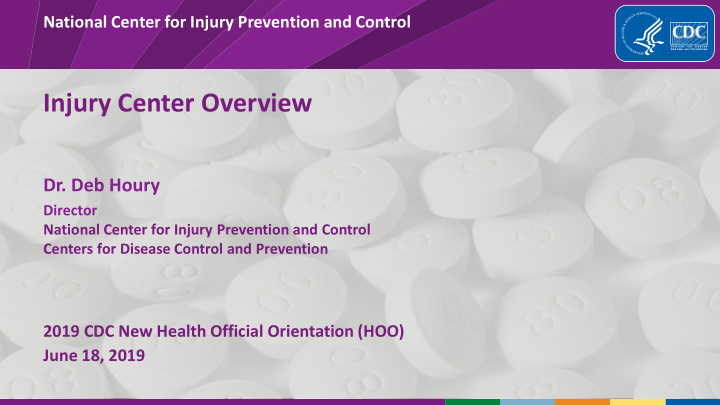



National Center for Injury Prevention and Control Injury Center Overview Dr. Deb Houry Director National Center for Injury Prevention and Control Centers for Disease Control and Prevention 2019 CDC New Health Official Orientation (HOO) June 18, 2019
Our Mission To prevent injuries and violence through science and action www.cdc.gov/injury
National Center for Injury Prevention and Control Appropriation (in millions) $700,000 $648,559 $648,559 $600,000 $500,000 $400,000 $300,000 $286,059 $200,000 $236,059 $170,447 $100,000 $0 FY 2015 FY 2016 FY 2017 FY 2018 FY 2019
Opioid overdose Suicide prevention Adverse childhood prevention experiences (ACEs) prevention
Suicide Vital Signs
Ohio Suicide Epi-Aid 12.5% 2.7% Percent of students attempting suicide during cluster
Expanded National Violent Death Reporting System to all 50 States
Adverse Childhood Experiences (ACEs)
Expanded Essentials for Childhood (EfC) Awardees to Seven States Seven EfC Awardees • California • Colorado • Kansas • Massachusetts • North Carolina • Utah • Washington
Helping States and Communities Take Advantage of the Best Available Evidence https://www.cdc.gov/violenceprevention/pub/technical-packages.html
CDC’s Approach: Opioid Overdose Prevention Build state, local, and tribal capacity Conduct surveillance and research Support providers, health systems, and payers Empower consumers to make safe choices Partner with public safety
More Specific, Timely, Localized, and Actionable Data Enhanced State Opioid Overdose Surveillance (ESOOS) Non-Fatal Data Use syndromic surveillance and hospital billing data to establish an early warning system to detect sharp increases or decreases in non-fatal opioid overdoses. Fatal Data Capture detailed information on toxicology, death scene investigations, and other risk factors that may be associated with a fatal overdose. Data for Action Rapidly disseminate surveillance findings to key stakeholders working to prevent or respond to opioid overdoses
March 2018
Opioid Rapid Response Teams
The Overdose Response Strategy Original HIDTAs Expansion 1 Expansion 2 Expansion 3 Expansion 4
Public Health/Public Safety Partnerships Overdose Response Strategy (ORS) HIDTA Combating Opioid Overdose Through Community-Level ONDCP Intervention Initiatives (COOCLI) Rural Communities Initiative & Bureau of Justice Assistance (BJA) Overdose Detection Mapping Application (ODMAP) Pilot Sites National Governors Association Reducing Overdose Risk among Justice Involved Populations (NGA) Center for Best Practices Leveraging Public Health/Public Safety Partnerships to Reduce Bloomberg RxStat Opioid Initiative Opioid Overdose: Best Practices Toolkit Organized Crime Drug Enforcement Improving Public Health Surveillance by Rapid Testing of Unknown Task Forces (OCDEFT) Substances
Rape Prevention and Education
Core State Violence and Injury Prevention Program (Core SVIPP)
WISQARS (Web-based Injury Statistics Query and Reporting System)
For more information, contact CDC www.cdc.gov/injury @CDCInjury 1-800-CDC-INFO (232-4636) TTY: 1-888-232-6348 The findings and conclusions in this report are those of the authors and do not necessarily represent the official position of the Centers for Disease Control and Prevention.
Recommend
More recommend